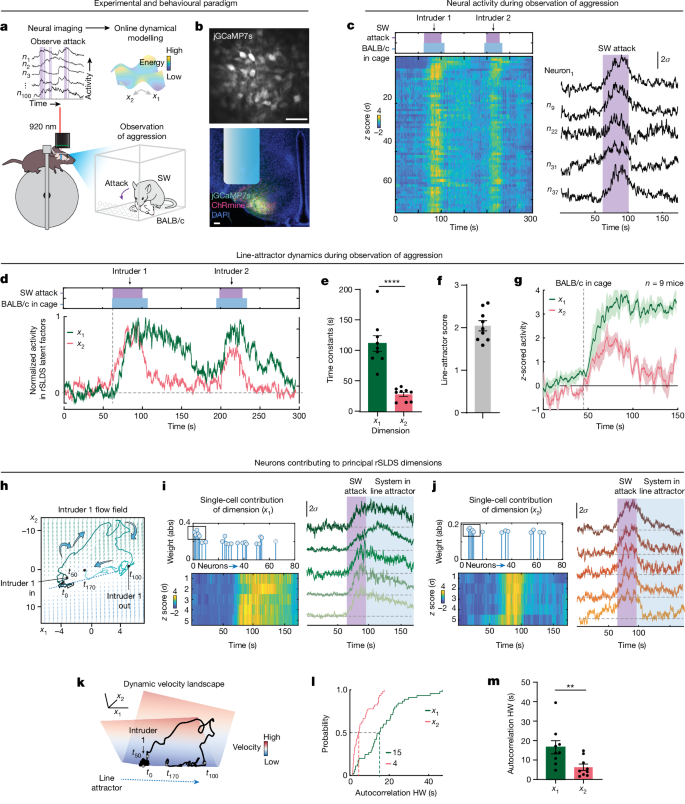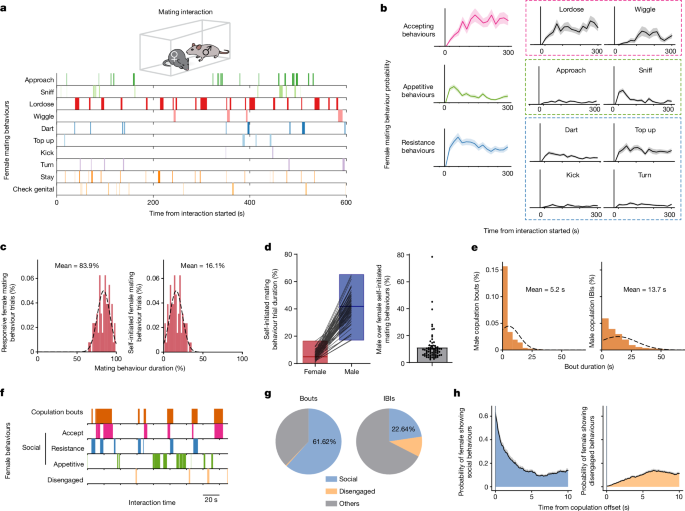2024-10-23 カリフォルニア工科大学(Caltech)
<関連情報>
- https://www.caltech.edu/about/news/decoding-aggression-and-arousal-in-the-brain
- https://www.cell.com/cell/fulltext/S0092-8674(24)00906-1
- https://www.nature.com/articles/s41586-024-07915-x
- https://www.nature.com/articles/s41586-024-07916-w
- https://www.sciencedirect.com/science/article/pii/S0896627321009958
持続的な内部状態をコードするラインアトラクターは神経ペプチドシグナルを必要とする A line attractor encoding a persistent internal state requires neuropeptide signaling
George Mountoufaris∙ Aditya Nair∙ Bin Yang∙ … ∙ Samuel Kim∙ Scott W. Linderman∙ David J. Anderson
Cell Published:August 26, 2024
DOI:https://doi.org/10.1016/j.cell.2024.08.015
Graphical abstract
Highlights
•“CRISPRoscopy” integrates calcium imaging and gene editing in the same neuronal cell type
•Co-editing of Oxtr and AVPr1a genes in VMHEsr1 neurons reduces aggression but not mounting
•A line attractor encoding a scalable, persistent aggressive internal state is eliminated
•Line attractor implementation in the hypothalamus requires neuropeptide signaling
Summary
Internal states drive survival behaviors, but their neural implementation is poorly understood. Recently, we identified a line attractor in the ventromedial hypothalamus (VMH) that represents a state of aggressiveness. Line attractors can be implemented by recurrent connectivity or neuromodulatory signaling, but evidence for the latter is scant. Here, we demonstrate that neuropeptidergic signaling is necessary for line attractor dynamics in this system by using cell-type-specific CRISPR-Cas9-based gene editing combined with single-cell calcium imaging. Co-disruption of receptors for oxytocin and vasopressin in adult VMH Esr1+ neurons that control aggression diminished attack, reduced persistent neural activity, and eliminated line attractor dynamics while only slightly reducing overall neural activity and sex- or behavior-specific tuning. These data identify a requisite role for neuropeptidergic signaling in implementing a behaviorally relevant line attractor in mammals. Our approach should facilitate mechanistic studies in neuroscience that bridge different levels of biological function and abstraction.
情動状態をコードするラインアトラクターの因果的証拠 Causal evidence of a line attractor encoding an affective state
Amit Vinograd,Aditya Nair,Joseph H. Kim,Scott W. Linderman & David J. Anderson
Nature Published:14 August 2024
DOI:https://doi.org/10.1038/s41586-024-07915-x

Abstract
Continuous attractors are an emergent property of neural population dynamics that have been hypothesized to encode continuous variables such as head direction and eye position1,2,3,4. In mammals, direct evidence of neural implementation of a continuous attractor has been hindered by the challenge of targeting perturbations to specific neurons within contributing ensembles2,3. Dynamical systems modelling has revealed that neurons in the hypothalamus exhibit approximate line-attractor dynamics in male mice during aggressive encounters5. We have previously hypothesized that these dynamics may encode the variable intensity and persistence of an aggressive internal state. Here we report that these neurons also showed line-attractor dynamics in head-fixed mice observing aggression6. This allowed us to identify and manipulate line-attractor-contributing neurons using two-photon calcium imaging and holographic optogenetic perturbations. On-manifold perturbations yielded integration of optogenetic stimulation pulses and persistent activity that drove the system along the line attractor, while transient off-manifold perturbations were followed by rapid relaxation back into the attractor. Furthermore, single-cell stimulation and imaging revealed selective functional connectivity among attractor-contributing neurons. Notably, individual differences among mice in line-attractor stability were correlated with the degree of functional connectivity among attractor-contributing neurons. Mechanistic recurrent neural network modelling indicated that dense subnetwork connectivity and slow neurotransmission7 best recapitulate our empirical findings. Our work bridges circuit and manifold levels3, providing causal evidence of continuous attractor dynamics encoding an affective internal state in the mammalian hypothalamus.
視床下部のラインアトラクターによる女性の交尾ダイナミクスの符号化 Encoding of female mating dynamics by a hypothalamic line attractor
Mengyu Liu,Aditya Nair,Nestor Coria,Scott W. Linderman & David J. Anderson
Nature Published:14 August 2024
DOI:https://doi.org/10.1038/s41586-024-07916-w

Abstract
Females exhibit complex, dynamic behaviours during mating with variable sexual receptivity depending on hormonal status1,2,3,4. However, how their brains encode the dynamics of mating and receptivity remains largely unknown. The ventromedial hypothalamus, ventrolateral subdivision contains oestrogen receptor type 1-positive neurons that control mating receptivity in female mice5,6. Here, unsupervised dynamical system analysis of calcium imaging data from these neurons during mating uncovered a dimension with slow ramping activity, generating a line attractor in neural state space. Neural perturbations in behaving females demonstrated relaxation of population activity back into the attractor. During mating, population activity integrated male cues to ramp up along this attractor, peaking just before ejaculation. Activity in the attractor dimension was positively correlated with the degree of receptivity. Longitudinal imaging revealed that attractor dynamics appear and disappear across the oestrus cycle and are hormone dependent. These observations suggest that a hypothalamic line attractor encodes a persistent, escalating state of female sexual arousal or drive during mating. They also demonstrate that attractors can be reversibly modulated by hormonal status, on a timescale of days.
愛ではなく戦争を起こす: 女性の社会行動における状態依存的スイッチの根底にある神経基盤 Make war not love: The neural substrate underlying a state-dependent switch in female social behavior
Mengyu Liu, Dong-Wook Kim, Hongkui Zeng, David J. Anderson
Neuron Published: January 3, 2022
DOI:https://doi.org/10.1016/j.neuron.2021.12.002
Graphical abstract

Highlights
- scRNA-seq reveals distinct cell types in female VMHvl active in mating versus aggressive behaviors
- Activation of VMHvlEsr1+,Npy2r- (α) cells promotes mating behaviors in virgins
- Activation of VMHvlNpy2r+ (β) cells promotes aggression in both virgins and dams
- Response of β, but not α, cells to male social cues increases in lactating dams
Summary
Female mice exhibit opposing social behaviors toward males depending on their reproductive state: virgins display sexual receptivity (lordosis behavior), while lactating mothers attack. How a change in reproductive state produces a qualitative switch in behavioral response to the same conspecific stimulus is unknown. Using single-cell RNA-seq, we identify two distinct subtypes of estrogen receptor-1-positive neurons in the ventrolateral subdivision of the female ventromedial hypothalamus (VMHvl) and demonstrate that they causally control sexual receptivity and aggressiveness in virgins and lactating mothers, respectively. Between- and within-subject bulk-calcium recordings from each subtype reveal that aggression-specific cells acquire an increased responsiveness to social cues during the transition from virginity to maternity, while the responsiveness of the mating-specific population appears unchanged. These results demonstrate that reproductive-state-dependent changes in the relative activity of transcriptomically distinct neural subtypes can underlie categorical switches in behavior associated with physiological state changes.



